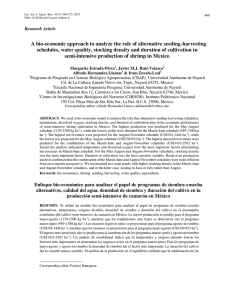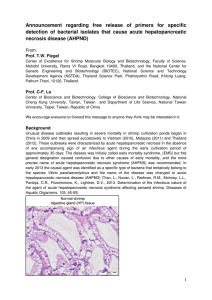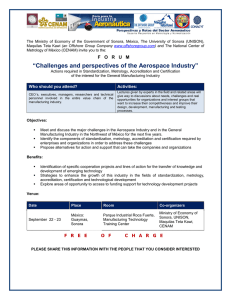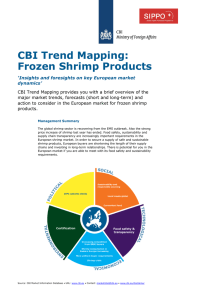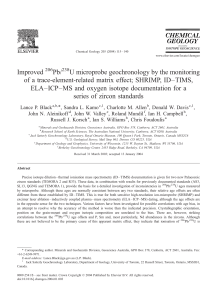Budget and discharges of nutrients to the Gulf of California of a semi
Anuncio
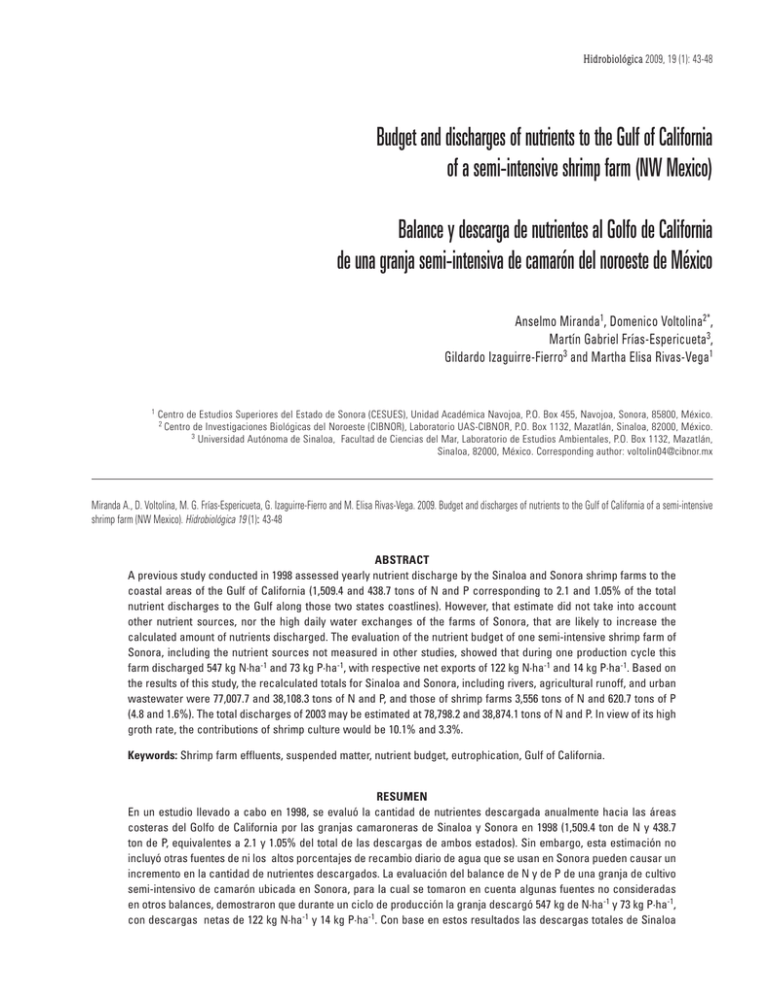
Hidrobiológica 2009, 19 (1): 43-48 Budget and discharges of nutrients to the Gulf of California of a semi-intensive shrimp farm (NW Mexico) Balance y descarga de nutrientes al Golfo de California de una granja semi-intensiva de camarón del noroeste de México Anselmo Miranda1, Domenico Voltolina2*, Martín Gabriel Frías-Espericueta3, Gildardo Izaguirre-Fierro3 and Martha Elisa Rivas-Vega1 1 Centro de Estudios Superiores del Estado de Sonora (CESUES), Unidad Académica Navojoa, P.O. Box 455, Navojoa, Sonora, 85800, México. 2 Centro de Investigaciones Biológicas del Noroeste (CIBNOR), Laboratorio UAS-CIBNOR, P.O. Box 1132, Mazatlán, Sinaloa, 82000, México. 3 Universidad Autónoma de Sinaloa, Facultad de Ciencias del Mar, Laboratorio de Estudios Ambientales, P.O. Box 1132, Mazatlán, Sinaloa, 82000, México. Corresponding author: voltolin04@cibnor.mx Miranda A., D. Voltolina, M. G. Frías-Espericueta, G. Izaguirre-Fierro and M. Elisa Rivas-Vega. 2009. Budget and discharges of nutrients to the Gulf of California of a semi-intensive shrimp farm (NW Mexico). Hidrobiológica 19 (1): 43-48 ABSTRACT A previous study conducted in 1998 assessed yearly nutrient discharge by the Sinaloa and Sonora shrimp farms to the coastal areas of the Gulf of California (1,509.4 and 438.7 tons of N and P corresponding to 2.1 and 1.05% of the total nutrient discharges to the Gulf along those two states coastlines). However, that estimate did not take into account other nutrient sources, nor the high daily water exchanges of the farms of Sonora, that are likely to increase the calculated amount of nutrients discharged. The evaluation of the nutrient budget of one semi-intensive shrimp farm of Sonora, including the nutrient sources not measured in other studies, showed that during one production cycle this farm discharged 547 kg N·ha-1 and 73 kg P·ha-1, with respective net exports of 122 kg N·ha-1 and 14 kg P·ha-1. Based on the results of this study, the recalculated totals for Sinaloa and Sonora, including rivers, agricultural runoff, and urban wastewater were 77,007.7 and 38,108.3 tons of N and P, and those of shrimp farms 3,556 tons of N and 620.7 tons of P (4.8 and 1.6%). The total discharges of 2003 may be estimated at 78,798.2 and 38,874.1 tons of N and P. In view of its high groth rate, the contributions of shrimp culture would be 10.1% and 3.3%. Keywords: Shrimp farm effluents, suspended matter, nutrient budget, eutrophication, Gulf of California. RESUMEN En un estudio llevado a cabo en 1998, se evaluó la cantidad de nutrientes descargada anualmente hacia las áreas costeras del Golfo de California por las granjas camaroneras de Sinaloa y Sonora en 1998 (1,509.4 ton de N y 438.7 ton de P, equivalentes a 2.1 y 1.05% del total de las descargas de ambos estados). Sin embargo, esta estimación no incluyó otras fuentes de ni los altos porcentajes de recambio diario de agua que se usan en Sonora pueden causar un incremento en la cantidad de nutrientes descargados. La evaluación del balance de N y de P de una granja de cultivo semi-intensivo de camarón ubicada en Sonora, para la cual se tomaron en cuenta algunas fuentes no consideradas en otros balances, demostraron que durante un ciclo de producción la granja descargó 547 kg de N·ha-1 y 73 kg P·ha-1, con descargas netas de 122 kg N·ha-1 y 14 kg P·ha-1. Con base en estos resultados las descargas totales de Sinaloa 44 Miranda., et al. y Sonora, incluyendo ríos, agricultura y las aguas urbanas, fueron 77,007.7 y 38,108.3 ton de N y P, respectivamente; siendo las contribuciones de la camaronicultura de 3,556 tons de N y 620.7 tons de P (4.8 y 1.6%). El total de las descargas para 2003 se puede estimar en 78,798.2 y 38,874.1 ton de N y de P. En vista de su rápido crecimiento, las contribuciones de la camaronicultura se calcularon en 10.1% y 3.3%. Palabras clave: Efluentes de granjas camaroneras, material suspendido, balance de nutrientes, eutrofización, Golfo de California. INTRODUCTION Approximately 82% of the 754 Mexican shrimp farms registered in 2003 and 92.5% of the more than 40·103 ha of pond surface are concentrated in the states of Sonora and Sinaloa, along the eastern coast of the Gulf of California (SAGARPA, 2004). In the state of Sinaloa they operate with two cycles·year-1 and their daily water renewal ranges from 2 to 10%, with an average of 4% (PáezOsuna, 2001). Those of Sonora operate with one cycle·year-1 and, because of the high evaporation and shrimp biomass, their mean daily water renewal rate is > 10-12% (Panorama Acuícola, 2004). Assuming a 5% average daily water renewal in 1-m deep ponds, the overall daily wastewater discharged would be 28·106 m3·d-1 with a total annual discharge (corresponding to 8 months of production) of 6.7·109 m3·year-1, which are less than 0.006% of the total volume of the Gulf (123,000 km3). Therefore, when compared to other nutrient sources, shrimp farm effluents are unlikely to affect the trophic status of the Gulf at a global scale, but could significantly contribute to local eutrophication of coastal waters, lagoons, and embayments (Páez-Osuna et al., 1997). The aim of this study was to obtain detailed information on the nitrogen and phosphorus inputs, and outputs of a semi-intensive shrimp farm operating with high daily water exchanges, calculate the respective yearly budgets and use the information for a global estimate of the nutrient discharges of the Sonora shrimp farms. MATERIAL AND METHODS The southern zone of Sonora state has eight shrimp parks (designated by the Sonora government as groups of farms located in a common area). This study was carried out in the semi-intensive shrimp farm Chomojabiri (26º 42.312’ to 26º 42.615 Lat N and 109º 37.596’ to 109º 37.858’ Long W), which is part of the Santa Barbara shrimp park (COSAES, 2008) (Figure 1). The fluxes of N and P were calculated considering the sum of the input sources (influent water, precipitation, food, postlarvae and fertilizers) and the outputs (shrimp harvested, effluent water, and associated fauna. Table 1). To obtain information on the characteristics of influent and effluent water, one sampling station was located close (50 m) to the pumping station, and the second was in the common effluent ditch. During the 2003 shrimp production cycle, six samples were collected from each station at four hour intervals during 24 hours every two weeks (Miranda et al., 2007) and stored on ice until analyis. In the laboratory, triplicate 250 ml aliquots were filtered through Whatman GF-C glass fiber filters. The organic N and the total P content of the particles retained on the filters were determined with the Kjeldahl method (Rodier, 1981), and determining reactive P-PO43- after acid persulfate digestion (Hach, 1992). Dissolved N-NO3-, N-NO2-, N-NH4+, P-PO43- were determined using standard procedures (Strickland & Parsons, 1972). Dissolved nonreactive P was obtained with the technique used for reactive PPO43- after acid persulfate digestion and the nonreactive fraction was calculated by difference with the untreated samples (Hach, 1992). Dissolved organic N was determined with the Kjeldahl method for water samples (Strickland & Parsons, 1972). The dissolved nutrient concentrations of rainwater were determined as for the seawater, using the samples obtained during the three rainfall events of the season. The organic N, and total P content of four shrimp food samples supplied by the farm management, obtained with the methods used for suspended particles, were 5.6% N, and 1.05% P. The amounts of N and P added as fertilizer were calculated using the information available from the ledgers of the farm on the type and quantity of fertilizers used throughout the cycle (85 kg·ha-1 urea with N = 46% and 12 kg·ha-1 monoammonium phosphate: N = 12%; P = 27%). The N and P content of L. vannamei (postlarvae and specimens harvested) were estimated from the information supplied in Boyd and Teichert-Coddington (1995). Those of the associated macrofauna (crabs) were estimated from the mean N and P content of several crustacean species (Boyd & Teichert-Coddington, 1995; Anger & Harms, 1990; Tacon, 1990; Zafar et al., 2004). The resulting total inputs were: 1) shrimp postlarvae, 2) total shrimp food and fertilizers added throughout the cycle, 3) amounts of dissolved and particulate N and P entering the farm, calculated from the nutrient contents of seawater and the water volumes used for the daily water exchanges Hidrobiológica 45 Nutrient budget of a semi-intensive shrimp farm The respective total N and P inputs were compared to the outputs (dissolved and particulate nutrients in the discharges and N and P contents of the shrimp and accompanying macrofauna biomass harvested at the end of the cycle) and the amounts of N exported through ammonia volatilization or adsorbed to the sediments were estimated as the difference between inputs and outputs (Páez-Osuna et al., 1997). RESULTS Pond water renewal started 29 days after postlarvae input to the pond and ranged between 5% and 20% of the total pond volume per day, with an average value of 12.7%·d-1. The respective N and P inputs from incoming waters amounted to 425 kg N·ha-1 (52.5% as organic particulate N; 41.4% as organic dissolved N and 6.1% as dissolved inorganic N) and 59 kg P·ha-1 (44.1% dissolved and 55.9% particulate). Fertilizers were applied 7, 22 and 51 days after postlarvae input to the pond and the total food supplied was 4,295 ± 255 kg·ha-1. Postlarvae and precipitation were minor additional inputs (Table 1). Figure 1. Chomojabiri farm localization, and grouping of shrimp farms (parks) in the south zone of Sonora. obtained from the ledgers of the farm, and 4) N and P contents of rainwater, calculated using the respective mean concentrations in rainwater samples and the total rainfall, obtained from the Navojoa meteorological station of the National Water Commission. The information available for the outputs were the dissolved and particulate nutrient content of the effluents (N = 547 kg·ha-1; P = 73 kg·ha-1, with respective net exports of 122 kg N and 14 kg P·ha-1) and 2,000 kg·ha-1 of shrimp harvested (11.4% N and 1.3% P (DW). Macrofauna (5 kg·ha-1 of portunid crabs) was equivalent to an output of 56-70 g N·ha-1 and 6-6.5 g P·ha-1. The 58.77 kg N·ha-1 and 20.7 kg P·ha-1 missing from the respective budgets were supposed to be lost to volatilization (N) or sedimentation (N and P) (Table 1). Table 1. Itemized nitrogen and phosphorus budgets, in kg·ha-1 and in percentages of total input and discharges, for the 2003 production cycle of the Chomojabiri shrimp farm. Others: estimated sedimentation and volatilization. N Source -1 % -1 P -1 kg·ha ·cycle % -1 kg·ha ·cycle INPUT Food 211.66 31.24 39.69 38.89 Influent water 425.00 62.74 59.00 57.81 Precipitation 0.20 0.03 0.12 0.12 Postlarvae 0.01 <0.01 0.001 <0.01 Fertilizers 40.54 5.98 3.24 3.16 Total 677.41 100.00 102.05 100.00 71.58 10.57 8.35 8.18 OUTPUT Shrimp harvested Effluent water Associated fauna 547.00 80.75 73.0 71.53 0.056-0.070 ≤0.01 0.006 <0.01 Others 58.77 8.68 20.70 20.28 Total 677.41 100.00 102.05 100.00 Vol. 19 No. 1 • 2009 46 Miranda., et al. DISCUSSION particles present in coastal waters are of detrital origin, with N and P contents that may differ from the Redfield ratio depending on their origin and on the processes involved in their formation. In our case, the atom to atom N:P ratio calculated for the organic particulates of the input was 15:1, close to the value typical of marine plankton (Riley, 1970; Raymont, 1980), whereas the respective ratios for the suspended solids discharged and for the total exports were 14:1 and 10.6:1. Some difficulties for the direct comparison of nutrient budgets of shrimp farms can be attributed to differences in water sampling strategies (Páez-Osuna et al., 1997) but the main problem is the lack of quantification of all inputs and outputs, in particular for dissolved organic N species, which may be fairly different in different natural coastal environments. In addition, any increase of their concentration in the effluent is due to leaching from food and faeces not recycled within the pond, that would otherwise be available for biogeochemical recycling by bacteria and phytoplankton (Jackson et al., 2003). In this study, the respective amounts of dissolved organic and inorganic N were176 and 26 kg·ha-1 (87.1% and 12.9%) in the inflow and 236 and 45 kg·ha-1 (84% and 16%) in the outflow, which shows that failure to quantify the organic N inputs and outputs seriously underestimates the global N budget and N net losses. Therefore, using particulate organic matter P values from either direct particle analysis or from Redfield ratio calculation would result in significant budget differences.The atomic 15:1 N vs. P ratio measured in inflowing waters corresponded to a mass ratio of 6.77:1, in comparison to the 7.23:1 ratio that would have been derived from the Redfield ratio. Similarly, the N vs. P mass ratio measured in outflowing waters was 6.33:1 and that calculated for the total export was 4.78:1. These changes confirm that a sizeable part of these solids were nonliving particulates with a high P content. The same consideration applies to dissolved nonreactive P, which in this study was between 25% and 30% of the dissolved P species and close to 10% of the total P input and output, showing that its contribution should be considered for a correct estimate of the P budget. Therefore, an incomplete quantification or the indirect estimate of all nutrient sources would have led, in our case, to underestimate the net export of N by close to 60%, while overestimating the net export of particulate N by almost 25%. The measured net export of P was 16.5% higher than the one calculated from the Redfield ratio, which does not account for the contribution of nonreactive dissolved P (Table 2). Some N and P budgets (Páez-Osuna et al., 1997; Páez-Osuna, 2001). have been based on the use of the traditional Redfield ratio of 16N : 1P (atom to atom) or 7.23N : 1P (mass to mass) which, considering the stoichiometric relations of the main constituents of plankton biomass, would give N and P contents equivalent to 6.3 and 0.87% of the organic mass. However, the relative N and P contents of living plankton may strongly deviate from the Redfield ratio, due to luxury P uptake (Nalewajko & Lean, 1980), to protein consumption due to respiration, or because of dark excretion of part of the P cell quota (Brown & Harris, 1978; Gómez-Villa et al., 2005). In addition, a high percentage of the total suspended Previous evaluations of the nutrient discharges of the Sinaloa and Sonora shrimp farms have not considered the complete range of dissolved N and P species, and used the Redfield ratio to estimate the particulate nutrient discharges. For instance, Páez-Osuna (2001), calculated that the joint contribution of the 20,500 ha of Sinaloa and 3,200 ha of Sonora that were supposed to be in operation during 1998 were 1,509.3 and 438.7 tons of N Table 2. Itemized nitrogen and phosphorus inputs, outputs and net discharges (in kg·ha-1) of the Chomojabiri farm, calculated from the field data of this study (A), or without the evaluation of dissolved organic N and nonreactive P (Nr P) and estimating particulate N and P from the Redfield ratio (B). Diss. N (inorg) Diss. N (org) Part. N ΣN PO43- Nr P P Part. 10 ΣP Input 26 176 223 425 19.5 6.5 33.0 59.0 Output 45 236 266 547 23.3 7.7 42.0 73.0 Net 19 60 43 122 3.8 1.2 9.0 14.0 Input 26 -- 291 317 20 -- 40.0 59.5 Output 45 -- 349 394 23 -- 48.2 71.5 Net 19 -- 58 77 3 -- 8.2 11.2 A B Hidrobiológica 47 Nutrient budget of a semi-intensive shrimp farm Table 3. Evaluation of nitrogen and phosphorus discharges of the Sinaloa and Sonora shrimp farms in 1998 according to Paéz-Osuna (2001)*, and recalculated according to the results of this study. Global discharges = including agriculture, rivers and municipal wastewater. N* P* N P Sinaloa 1,305.6 379.5 1,816.8 528.1 Sonora 203.8 59.2 639.9 186.0 Total 1,509.4 438.7 2,456.7 714.1 Global discharges 71,952.1 41,908.5 74,007.7 42,090.5 and P, equivalent to 2.1 and 1.05% of the total discharges, including rivers, agricultural runoff and municipal wastewaters. However, these estimates did not acknowledge that the farms in Sinaloa operate with low mean water renewal rates (≈ 4%: Páez-Osuna, 2001) because of the high relative humidity and summer rains, whereas in Sonora water renewal rates range from 10 to 20%, to offset the salinity increases due to high evaporation. As a consequence of these higher water fluxes in Sonora shrimp farms, a sizeable part of the nutrients leached from shrimp food is not recycled within the pond and are exported with corresponding FCR values of more than 1.7 (Panorama Acuícola 2004, Miranda et al., 2007). Once revised by +39% (N) and +2% (P) (Table 2), the values calculated by Páez-Osuna (2001) may be considered as realistic for the 20,500 ha of Sinaloa, whereas our results should be used to estimate the output from the 3,200 ha of shrimp farms of the state of Sonora. Thus, the global discharges from the Sinaloa and Sonora shrimp farms can be reassesed as 3,565 tons of N and 620.7 tons of P, hence representing a contributions of 4.8% (N) and 1.6% (P) to the global nutrient loads from continental sources (Table 3). The populations of Sinaloa and Sonora have been increasing by 0.5 and 1.4% (INEGI, 2005) to close to 25.7 and 22.4·106 people, and it may be assumed that the municipal discharges have been increasing at a similar rate, whereas the surface dedicated to shrimp culture grew from the 23,700 ha operating in 1998 to 38,576 ha by 2003 and the increase had a faster rate in Sonora (from 3,200 to 10,047 ha) than in Sinaloa (20,500 to 28,529 ha in operation) (SAGARPA, 2004). Thus, assuming no changes in the river discharges or from agricultural runoff, in part because of the lack of additional suitable land and also because of the local advances in agricultural technology (greenhouse cultures with water recycling, extensive use of plasticulture and of drip irrigation), the shrimp farms may become an important factor in nutrient enrichment of coastal waters of the Gulf of California: according to the estimate by PáezOsuna (2001) corrected for the population increase in the case of municipal wastes, and using the values of table 3 for shrimp farms, the total discharges to the Gulf in 2003 were calculated as 78,998 and 38,874.1 tons of N and P, respectively. Most of the respective increases (1,790.5 tons of N and 765.8 tons of P) were due to shrimp farm discharges, and their contributions to Gulf nutrient enrichment may be calculated as 10.2 and 3.3% (Table 4). ACKNOWLEDGEMENTS The operating funds were provided by projects PAM6-2003, 6192 and AC1.4 of CESUES, CICESE and CIBNOR. Pedro Almada Tabla 4. Nutrient inputs to the Gulf of California in 2003, estimated from the data of Páez-Osuna (2001) for river, agriculture and municipal contributions (corrected for population growth) and from the results of this study for shrimp farming. P N Sonora Sinaloa Total Sonora Sinaloa Total River 2,531.0 7,107.0 9,638.0 4,442.0 11,908.0 16,350.0 Agriculture 1,731.0 24,388.0 26,119.0 28,436.0 20,920.0 49,356.0 Municipal 860.0 985.0 1,845.0 2,457.1 2,814.1 5,271.2 Aquaculture 733.4 538.7 1,272.1 5,495.5 2,525.3 8,020.8 Total 5,855.4 33,018.7 38,874.1 40,830.6 38,167.4 78,998.0 Vol. 19 No. 1 • 2009 48 Miranda., et al. and Guillermo Luque of the San Andrés Company allowed free access to the farm and to its ledgers. The first author acknowledges the support of a PROMEP scholarship during his Ph. D. studies at CICESE. REFERENCES Anger, K. & J. Harms. 1990. Elemental (CHN) and proximate biochemical composition of decapod crustacean larvae. Composition Biochemical Physiology 97B: 69-80. Nalewajko, C. & D. R. S. Lean. 1980. Phosphorus. In: Morris, I. (Ed.). The Physiological Ecology of Phytoplankton. Univ. California Press, Berkeley. pp. 236-258. Páez-Osuna, F. 2001. Flujos y balance de masas de nutrientes en estanques camaronícolas. In: Páez-Osuna, F. (Ed.). Camaronicultura y Medio Ambiente. Universidad Nacional Autónoma de México, Instituto de Ciencias del Mar y Limnología, Mexico DF. pp. 176-192. Páez-Osuna, F., S.R. Guerrero-Galván, A.C. Ruíz-Fernández & R. Espinoza-Angulo. 1997. Fluxes and mass balances of nutrients in a semi-intensive shrimp farm in North-Western Mexico. Marine Pollution Bulletin 34: 290-297. Boyd, C. E. & D. Teichert-Coddington. 1995. Dry matter, ash and elemental composition of pond cultured Penaeus vannamei and P. stylirostris. Journal of the World Aquaculture Society 26: 88-92. Panorama Acuícola. 2004. Acuicultura en el desierto. Panorama Brown, E. J. & R. F. Harris. 1978. Algal transient phosphate uptake Parsons, T. R., M. Takahashi & B. Hargrave. 1984. Biological kinetics and the cell quota concept. Limnology and Oceanography 23: 35-40. COSAES, 2008. Resultados 2003, rangos de producción por regiones. http://www.cosaes.com/ Gómez-Villa, H., D. Voltolina, M. Nieves & P. Piña. 2005. Biomass production and nutrient budget in outdoor cultures of Scenedesmus obliquus (Chlorophyceae) in artificial wastewater, under the winter and summer conditions of Mazatlán, Sinaloa, Mexico. Vie et Milieu 55: 121-126. Hach. 1992. Water Analysis Handbook 2nd Ed. Hach Company, Loveland, 831 p. Instituto Nacional de Estadística, Geografía e Informática (INEGI). 2005. II Conteo Nacional de Población y Vivienda 2005. http://www. inegi.gob.mx Jackson, G. A. & P. N. Williams. 1985. Importance of dissolved organic nitrogen and phosphorus to biological nutrient cycling. DeepSea Research 32: 223-235. Jackson, C., N. Preston, P. J. Thompson & M. Burford. 2003. Nitrogen budget and effluent nitrogen components at an intensive shrimp farm. Aquaculture 218: 397-411. Miranda, A., D. Voltolina, M. A. Brambilla-Gámez, M. G. FríasEspericueta & J. Simental. 2007. Effluent characteristics and nutrient loading of a semi-intensive shrimp farm in NW Mexico. Vie et Milieu 57: 21-27. Acuicola Magazine 9(5): 36-38. Oceanographic Processes. 3rd Ed. Pergamon Press, Oxford. 330 p. Raymont, J. E. G. 1980. Plankton and Productivity in the Oceans. 2nd Ed. Pergamon Press, Oxford and New York. 489 p. Riley, G. A. 1970. Particulate organic matter in seawater. Advances in Marine Biology 8: 1-118. Rodier, J. 1981. Análisis de las Aguas. Omega, Barcelona. 1059 p. Secretaría de Agricultura, Ganadería, Desarrollo Rural, Pesca y Alimentación (SAGARPA). 2004. Carta Nacional Pesquera. Diario Oficial de la Federación, Marzo 2004. Sección IV: 33-35. Strickland, J. D. H. & T. R. Parsons. 1972. A Practical Handbook of Seawater Analysis. 2nd Ed. Bulletin of the Fisheries Research Board of Canada No. 167. 311 p. Tacon, A. G. T. 1990. Standard Methods for the Nutrition of Farmed Fish and Shrimp Vol. 2. Nutrient Sources and Composition. Argent Laboratories Press, Redmond. 129 p. Zafar, M., S. M. Huda & H. M. Abdul. 2004. Biochemical composition in Scilla serrata (Foskal) of Chakaria Sundarban area, Bangladesh. Pakistan Journal of Biological Science 7(12): 2182-2186. Recibido: 21 de junio de 2008. Aceptado: 23 de febrero de 2009. Hidrobiológica
